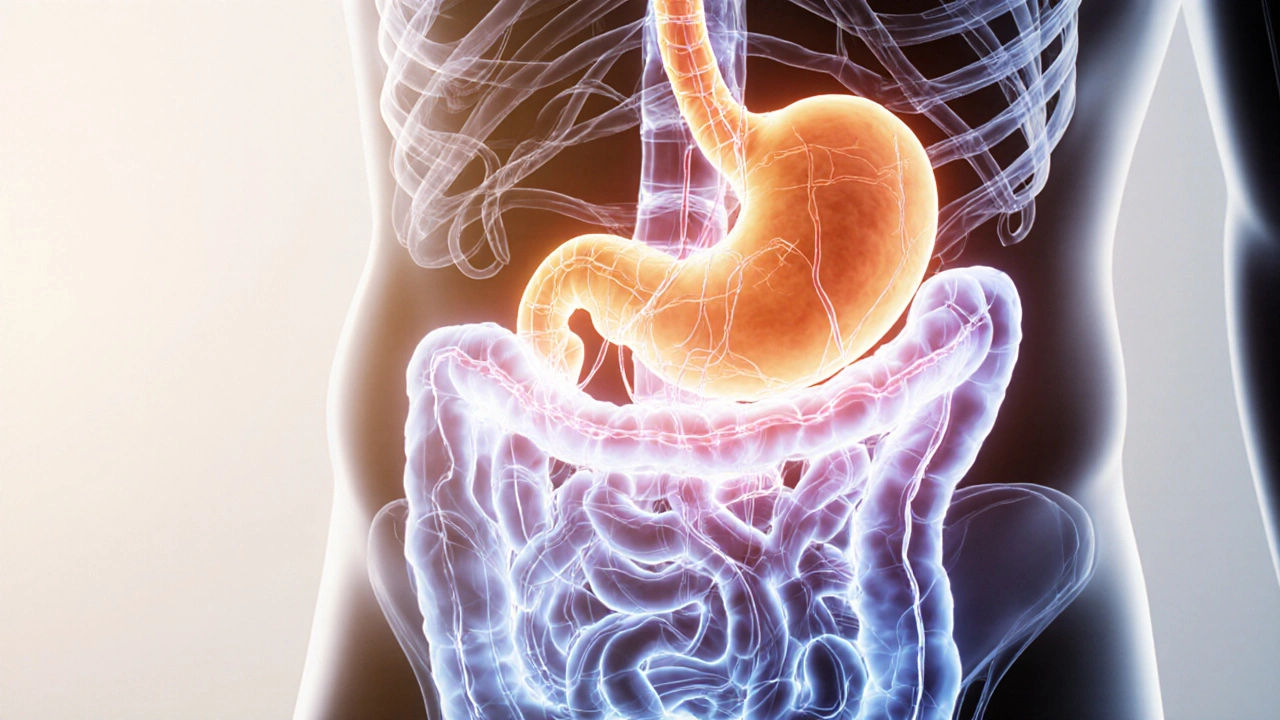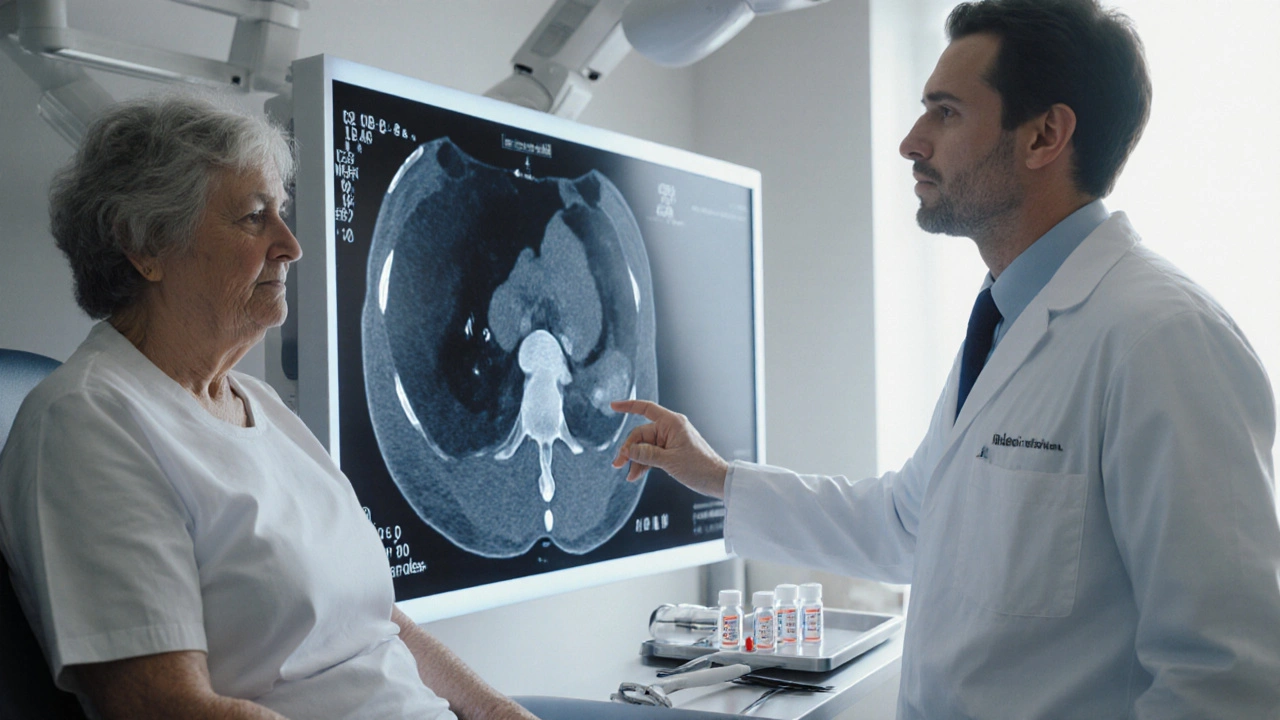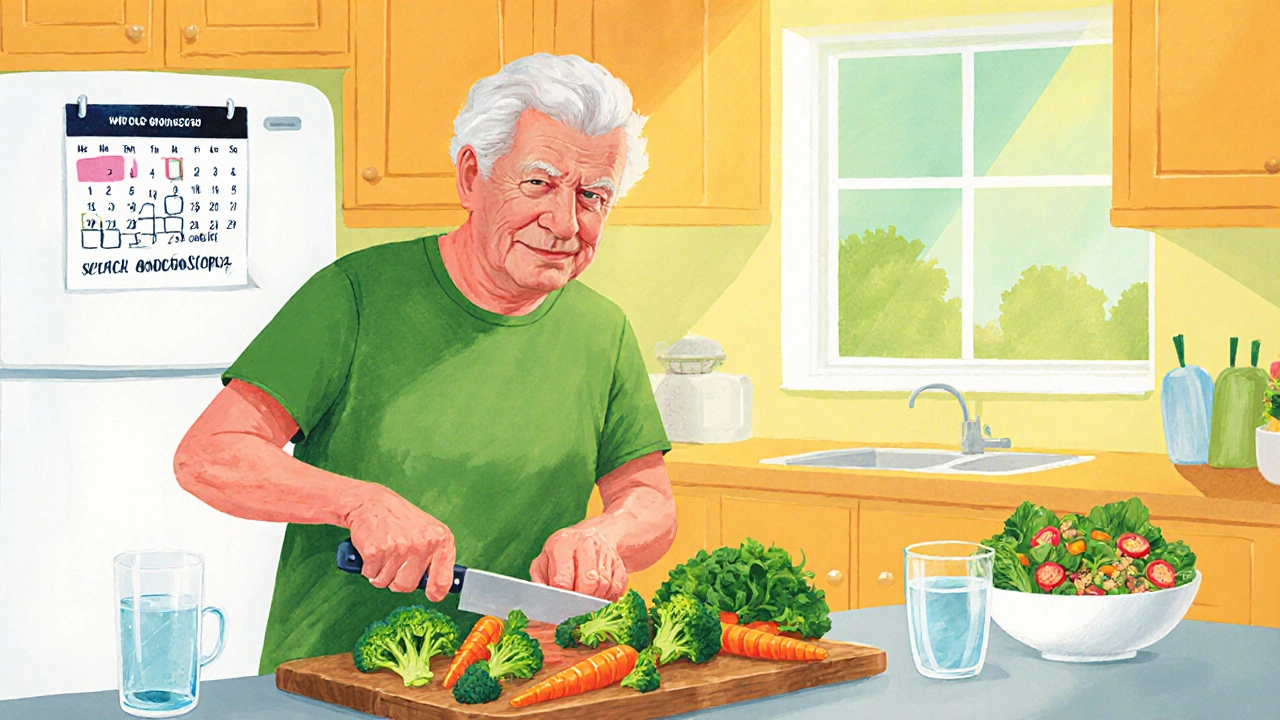Epigastric Pain and Colon Cancer: Key Facts You Must Know

Epigastric Pain & Colon Cancer Risk Assessment
Answer These Questions to Assess Your Risk
This tool helps determine if your epigastric pain might be related to colon cancer. Answer honestly for the most accurate assessment.
Your Risk Assessment
If you’re dealing with epigastric pain, you might wonder whether it’s just indigestion or something more serious. While most upper‑abdominal aches are harmless, they can sometimes signal colon cancer, especially when they appear alongside other warning signs.
What Is Epigastric Pain?
In medical terms, the epigastric region is the upper central part of the abdomen, just below the ribcage. Pain here is often described as burning, gnawing, or squeezing and can stem from the stomach, esophagus, pancreas, or even the heart.
- Common culprits include acid reflux, gastritis, and gallstones.
- Red‑flag causes are ulcers, pancreatitis, and, less frequently, malignancies.
Understanding the nature of the pain-its timing, triggers, and accompanying symptoms-helps narrow down the cause.
How Colon Cancer Can Present With Epigastric Pain
Colon cancer is a malignant growth that begins in the lining of the large intestine. Early tumors often grow silently, but as they enlarge or cause blockages, pain can radiate upward, manifesting as epigastric discomfort.
Why does a disease of the lower gut affect the upper belly? The answer lies in the way the gastrointestinal tract shares nerves and blood vessels. When a tumor causes inflammation, partial obstruction, or releases tumor‑derived substances, the sensation can be felt higher up.
Key patterns that suggest a cancer link include:
- Persistent pain lasting weeks despite lifestyle changes.
- Accompanying red‑flag symptoms such as unexplained weight loss, anemia, or changes in bowel habits.
- Family history of colorectal malignancies.
Who Is Most at Risk?
Several factors raise the odds of developing colon cancer, and many of these also influence how pain shows up.
- Age - risk climbs sharply after age 50.
- Family history - having a first‑degree relative with colon cancer roughly doubles risk.
- Diet - high consumption of red meat, processed foods, and low fiber intake are linked to higher incidence.
- Personal history of inflammatory bowel disease (IBD) or adenomatous polyps.
- Smoking and heavy alcohol use.
People with multiple risk factors should stay vigilant and discuss screening options with their physician.

How Colon Cancer Is Diagnosed When Pain Is the First Clue
When a clinician suspects a colorectal origin for epigastric pain, they typically follow a stepwise work‑up:
- Medical history and physical exam - focuses on pain characteristics, weight changes, and rectal bleeding.
- Laboratory tests - complete blood count (CBC) to check for anemia; carcinoembryonic antigen (CEA is a blood marker that can be elevated in colon cancer).
- Imaging studies - a contrast‑enhanced CT scan of the abdomen and pelvis visualizes masses, blockages, or metastatic spread.
- Colonoscopy - the gold standard; allows direct visualization and biopsy of suspicious lesions. The procedure also offers screening colonoscopy as a preventive measure for at‑risk adults.
- Pathology - tissue samples are examined for cancer type, grade, and molecular markers that guide treatment.
Early detection dramatically improves survival. For stageI disease, five‑year survival exceeds 90%; for stageIV, it drops below 15%.
When to Seek Immediate Medical Attention
Not every bout of upper‑abdominal ache demands a trip to the ER, but these signs warrant prompt evaluation:
- Severe, worsening pain that doesn’t improve with over‑the‑counter meds.
- Sudden onset of vomiting, especially if you can’t keep liquids down.
- Black or tarry stools (possible gastrointestinal bleeding).
- Unexplained fever, chills, or a rapid heartbeat.
- Rapid, unintentional weight loss (>5% of body weight in 6months).
These symptoms could indicate an advanced tumor, perforation, or another emergency.
Prevention, Screening, and Lifestyle Moves
While you can’t control age or genetics, many lifestyle choices lower colon‑cancer risk and may reduce unexplained epigastric discomfort.
- Eat a high‑fiber diet - at least 25‑30g daily from fruits, vegetables, and whole grains.
- Limit red and processed meats - aim for fewer than 2servings per week.
- Stay active - 150 minutes of moderate exercise per week cuts risk by about 20%.
- Maintain a healthy weight - obesity is linked to both colorectal cancer and chronic abdominal pain.
- Avoid tobacco and excess alcohol - both are independent risk factors.
- Regular screening - start at age45 for average‑risk adults; earlier (age40 or sooner) if you have a family history. Colonoscopy every 10years is the standard, though stool‑based tests can be alternatives.
Screening catches pre‑cancerous polyps before they turn malignant, effectively preventing many cancers.

Quick Comparison: Common Causes of Epigastric Pain vs. Colon Cancer‑Related Pain
| Aspect | Benign Upper‑GI Causes | Colon‑Cancer Related Pain |
|---|---|---|
| Onset | Often sudden after a heavy meal or alcohol | Gradual, persistent over weeks or months |
| Associated Symptoms | Heartburn, nausea, belching | Weight loss, anemia, change in bowel habits |
| Response to Antacids | Typically improves | Little to no relief |
| Risk Factors | Spicy food, stress, H. pylori | Age>50, family history, low‑fiber diet |
| Diagnostic Tests | Endoscopy, H. pylori breath test | CT scan, colonoscopy with biopsy |
Next Steps If You’re Concerned
Feeling uneasy about persistent epigastric pain? Here’s a practical routine:
- Track your pain for 2‑3weeks: note timing, foods, intensity, and any extra symptoms.
- Schedule a primary‑care visit; bring your pain diary.
- Ask specifically about screening colonoscopy guidelines for your age and risk profile.
- If recommended, complete any blood work (CBC, CEA) and imaging before the colonoscopy.
- Follow up on results promptly; discuss treatment options if a tumor is found.
Remember, early action saves lives and often spares you from more invasive treatments later on.
Frequently Asked Questions
Can colon cancer cause pain only in the upper abdomen?
Yes, especially when a tumor obstructs the bowel or triggers inflammation that radiates upward. However, isolated upper‑abdominal pain without other signs is more often linked to stomach or esophageal issues.
At what age should I start screening if I have a family history?
If a first‑degree relative was diagnosed before age60, screenings should begin at age40 or ten years earlier than the relative’s diagnosis, whichever comes first.
Is a blood test for CEA reliable for early detection?
CEA can help monitor known cancer or detect recurrence, but it isn’t sensitive enough to catch early‑stage disease on its own. It’s used alongside imaging and colonoscopy.
What lifestyle changes lower my risk the most?
Adopting a high‑fiber diet, limiting red and processed meats, exercising regularly, maintaining a healthy weight, and quitting smoking offer the biggest risk reduction.
If my colonoscopy is clear, can my epigastric pain still be serious?
A normal colonoscopy rules out colorectal cancer, but the pain could stem from other serious conditions like pancreatic disease or gallbladder inflammation. Follow‑up imaging or specialist referral may be needed.

Barry White Jr
October 6, 2025 AT 17:43Great info thanks for the rundown.
Andrea Rivarola
October 11, 2025 AT 08:49The article does a solid job breaking down how epigastric discomfort can sometimes be a warning sign for something as serious as colon cancer.
I especially appreciated the clear distinction between common benign causes and the red‑flag symptoms that should prompt further investigation.
The inclusion of a risk‑assessment tool is a nice practical touch, letting readers gauge their own situation before stepping into a doctor’s office.
It correctly emphasizes that persistent pain lasting weeks, especially when paired with weight loss or changes in bowel habits, is not something to ignore.
Age over fifty and a family history remain the classic risk factors, and the article restates those guidelines without unnecessary jargon.
I also liked the reminder that lifestyle modifications, like increasing fiber intake and limiting processed meats, can have a real impact on reducing risk.
The section on diagnostic steps is thorough, outlining the progression from basic blood work to imaging and finally colonoscopy.
Knowing that a colonoscopy not only detects cancer but can also remove precancerous polyps helps demystify the procedure for anxious readers.
The survival statistics presented are sobering yet motivating, showing how early detection dramatically improves outcomes.
The table comparing benign upper‑GI causes to colon‑cancer related pain serves as an at‑a‑glance reference that many will bookmark.
I would have liked to see a bit more discussion on how pancreatic or gallbladder disease can also mimic these symptoms, but the focus on colon cancer is understandable.
The FAQ at the end nicely addresses common concerns, such as the reliability of CEA blood tests and the appropriate age to begin screening.
Overall, the tone remains balanced-neither causing panic nor downplaying serious signs- which is exactly what health communication should aim for.
For anyone experiencing lingering upper abdominal pain, this article provides a solid roadmap for when to seek medical advice.
In short, it blends scientific accuracy with user‑friendly language, making a complex topic accessible without sacrificing depth.
Bryce Charette
October 13, 2025 AT 16:23I agree, the risk tool is handy, but remember that self‑diagnosis has limits.
Christina Burkhardt
October 17, 2025 AT 17:36Thanks for laying out the steps so clearly. If you have any of the red‑flag symptoms-persistent pain, unexplained weight loss, or a change in bowel habits-don’t wait for the tool to tell you. Make an appointment with your primary‑care physician and ask about a colonoscopy, especially if you’re over 50 or have a family history. Early detection can save lives, and the screening process has become much more comfortable in recent years.
liam martin
October 19, 2025 AT 11:16Life, in its quiet absurdity, offers us warning signs like pain to remind us we are finite. When the upper belly murmurs persistently, perhaps it is less about disease and more about the whisper of mortality urging us to heed the body’s counsel. Ignoring such signals is akin to refusing a mirror that reflects the inevitable decay we all share.
Ria Ayu
October 22, 2025 AT 22:36I can totally relate to the anxiety of not knowing whether that nagging ache is harmless or something more serious. It’s good to see an article that doesn’t just scare you but gives concrete steps. Keeping a symptom diary, as suggested, really helps both you and your doctor see patterns that might otherwise be missed.
Oscar Taveras
October 24, 2025 AT 07:56Indeed, maintaining a detailed log of pain episodes, dietary intake, and associated symptoms is a prudent practice. Such documentation facilitates a more focused clinical assessment and can expedite the decision‑making process regarding appropriate investigative modalities, be it imaging or endoscopic evaluation.
katie clark
October 27, 2025 AT 04:23While the exposition is thorough, one might argue the prose occasionally lapses into a pedestrian recapitulation of well‑known epidemiological data, thereby diminishing the scholarly gravitas expected of a treatise on oncologic vigilance.
Carissa Engle
October 28, 2025 AT 08:09Honestly this article is kind of a mess it tries to be everything at once the risk tool feels like a gimmick and the table is just a copy paste of generic info the author could’ve just linked to a wiki page why bother with all this filler it’s not helping anyone and the tone swings from clinical to chatty which is super confusing it could have been tighter focused and way more useful if they stripped the fluff.
Kyle Olsen
October 31, 2025 AT 19:29Having perused this composition, I must assert that whilst the author endeavors to be comprehensive, the piece suffers from a conspicuous lack of critical appraisal. The reliance on generic recommendations without delving into nuanced risk stratification renders the discourse rather pedestrian.
Mitchell Awisus
November 2, 2025 AT 02:03Indeed; the article provides a solid overview; however, a more detailed analysis of the sensitivity and specificity of various screening modalities would enhance its utility; additionally, incorporating recent guidelines from the American Cancer Society could further substantiate the recommendations.
Brandon Smith
November 5, 2025 AT 02:16From an ethical standpoint, the responsibility lies with the reader to act upon credible information. It is morally incumbent to prioritize evidence‑based interventions rather than succumb to sensationalized health narratives.
allen doroteo
November 6, 2025 AT 03:16Sure, but the whole “screen early” mantra is just another health scare. People get worried over nothing, and then doctors push more tests. It’s a cycle.
Oliver Behr
November 9, 2025 AT 17:23Screening saves lives.
Tiffany W
November 10, 2025 AT 15:36Utilizing evidence‑based colorectal cancer surveillance protocols, particularly fecal immunochemical testing (FIT) in conjunction with colonoscopic evaluation, constitutes a standard of care that mitigates oncogenic progression.